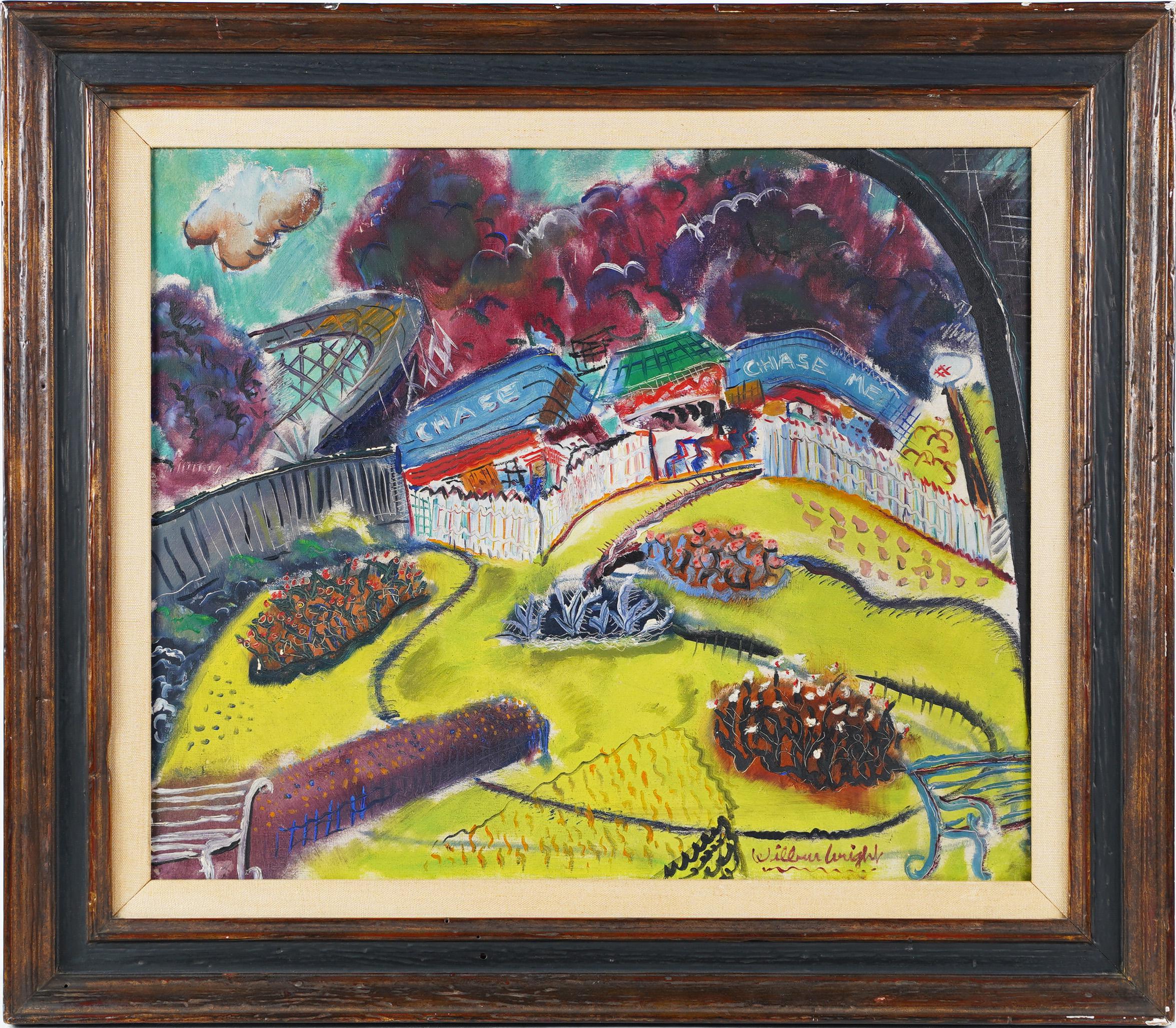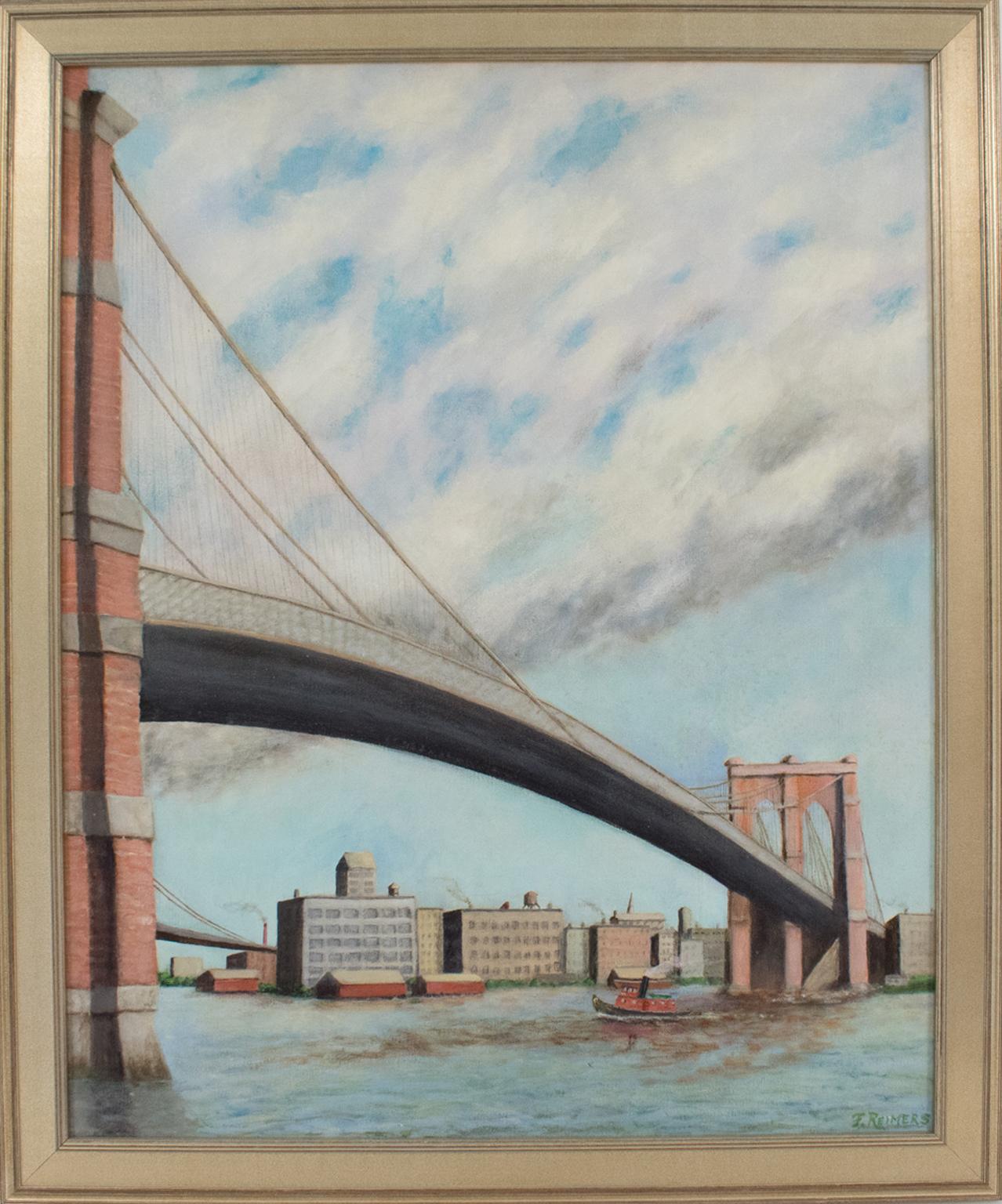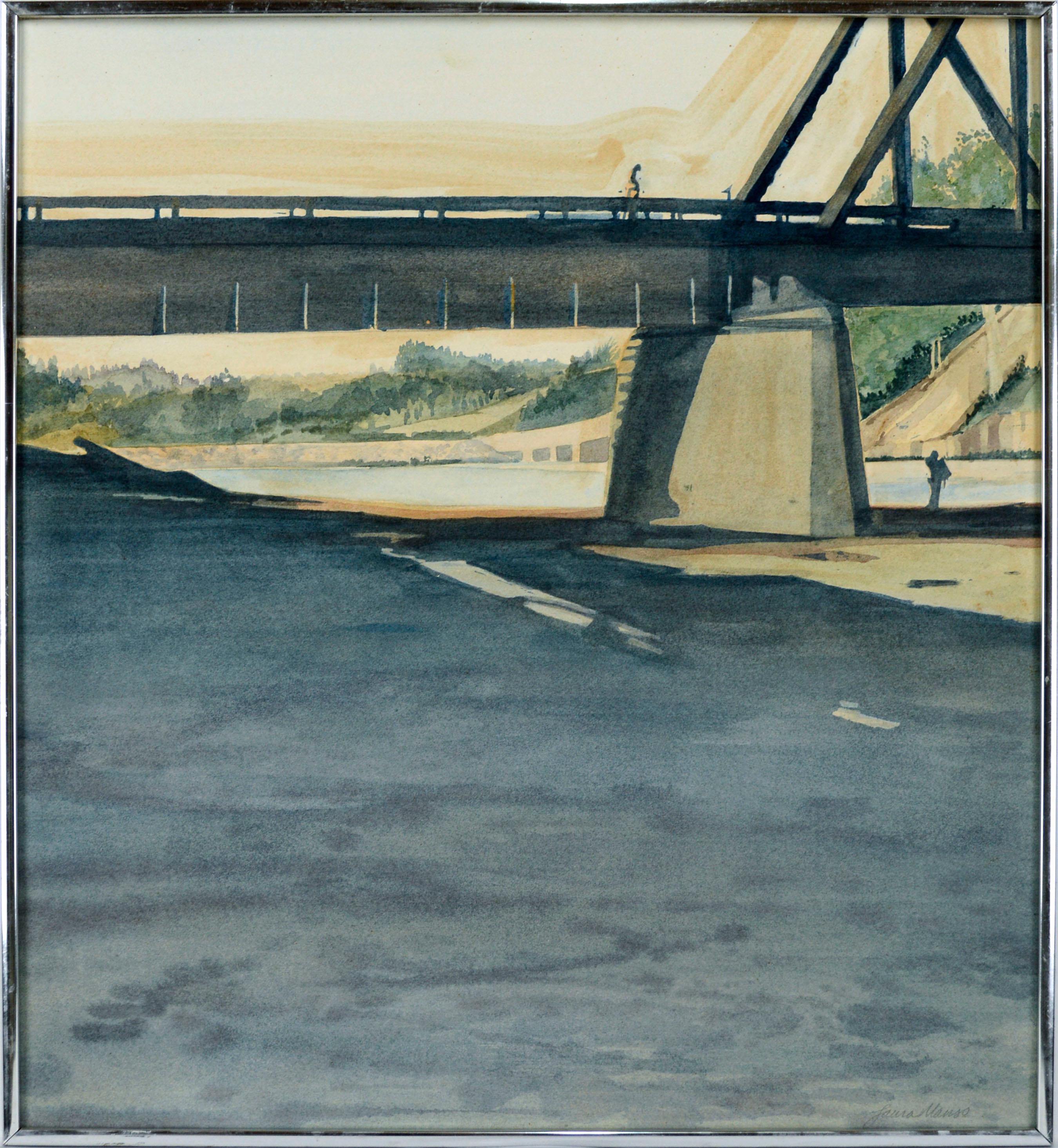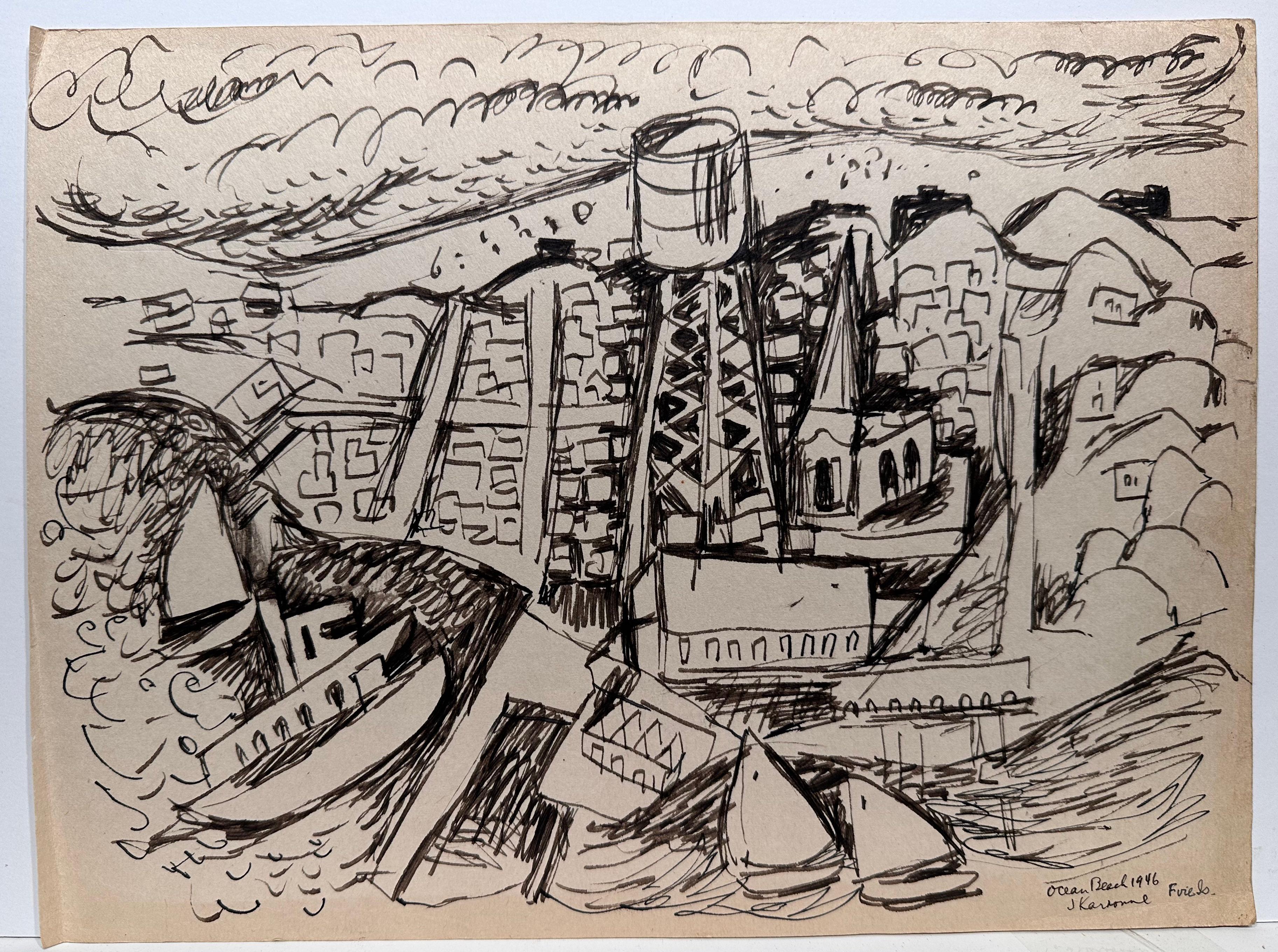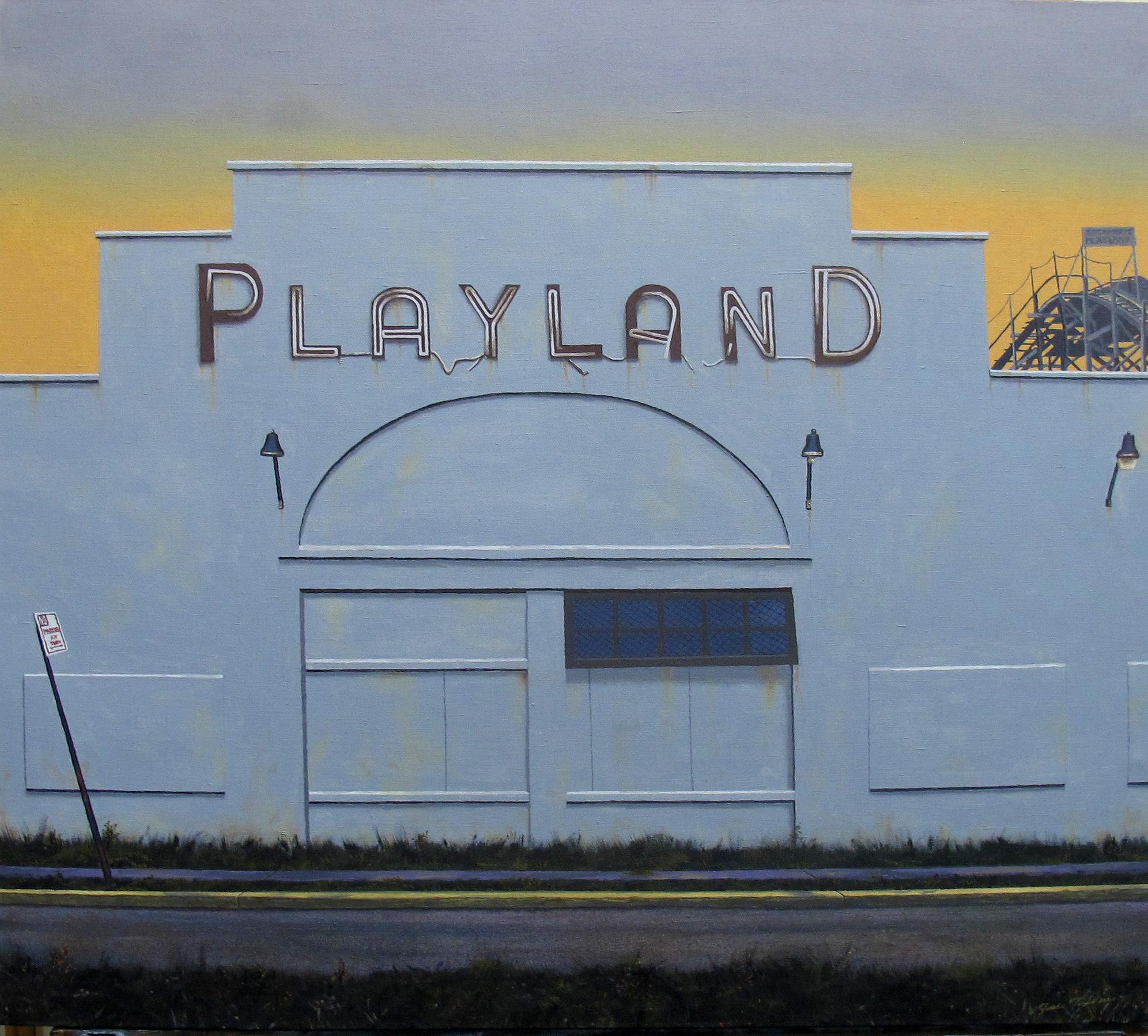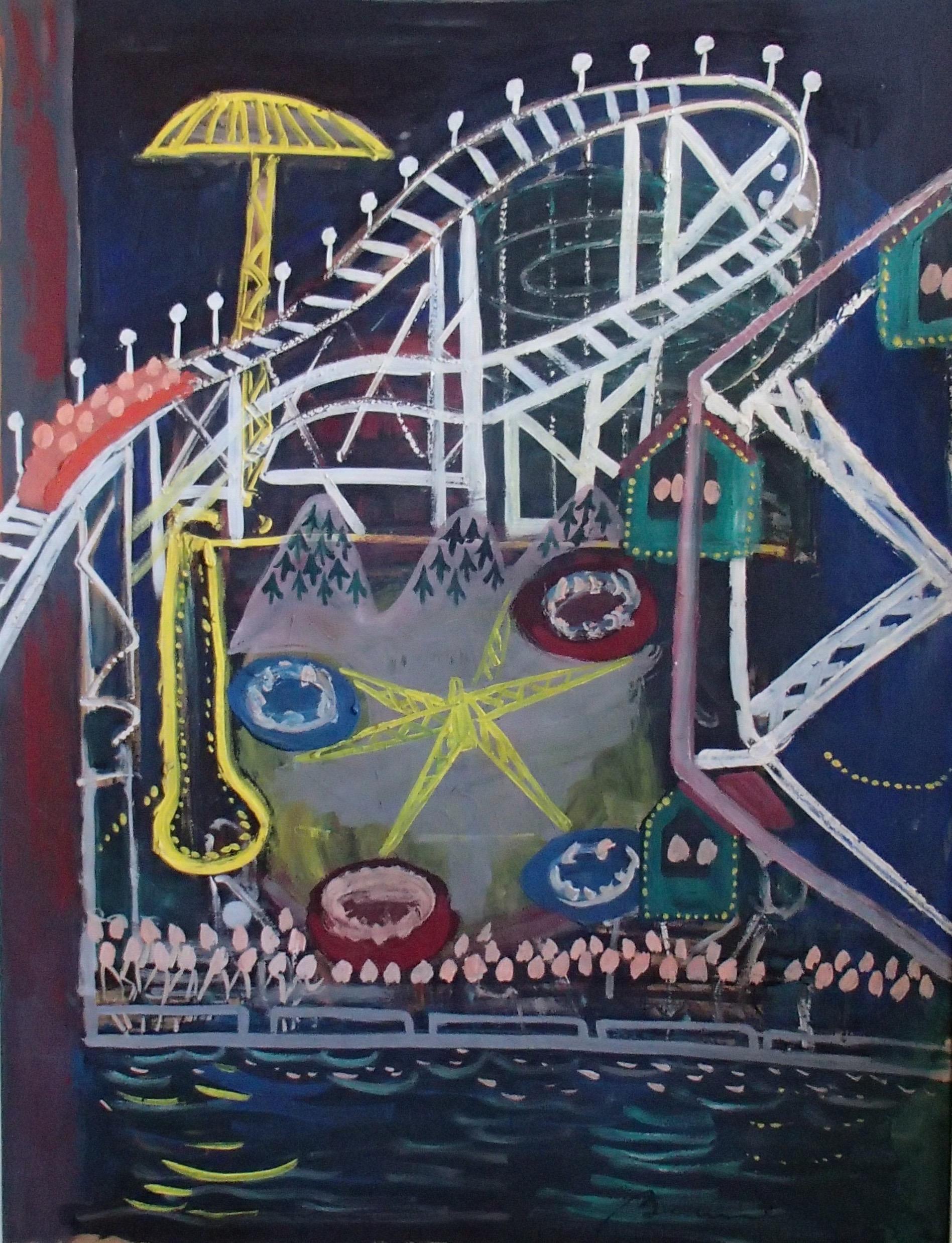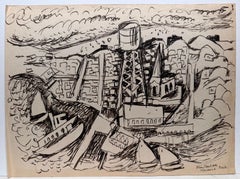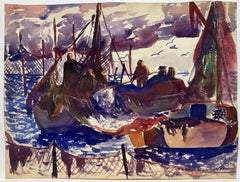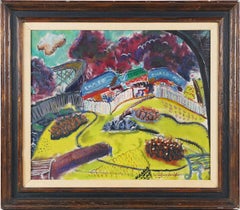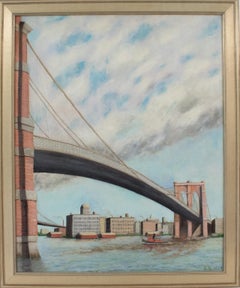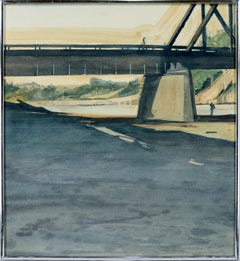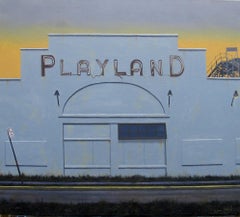Items Similar to Pleasure Beach Bridgeport CT Rollercoaster
Want more images or videos?
Request additional images or videos from the seller
1 of 9
Joseph KardonnePleasure Beach Bridgeport CT Rollercoaster1936
1936
$1,200
$1,50020% Off
£906.19
£1,132.7420% Off
€1,037.51
€1,296.8820% Off
CA$1,694.71
CA$2,118.3920% Off
A$1,850.22
A$2,312.7820% Off
CHF 970
CHF 1,212.4920% Off
MX$22,471.65
MX$28,089.5720% Off
NOK 12,113.66
NOK 15,142.0820% Off
SEK 11,438.53
SEK 14,298.1620% Off
DKK 7,743.88
DKK 9,679.8520% Off
About the Item
Joseph Kardonne (1911-1985). Pleasure Beach, Bridgeport, CT, 1936. Gouache on cardboard panel, 11.5 x 18 inches. Signed, dated and titled lower right.
Born in Newark, New Jersey in 1911, Joe Kardonne first showed an interest in art at an early age. At 15 years old he turned professional by painting murals for a large department store in his hometown. He formed his own business and found success in the commercial art field with the Kardonne Advertising Agency. In the 1930's he branched out into photography. His photographs, even today, could be considered cutting edge. He soon discovered that his true passion was painting and decided to devote his life to the fine arts. He joined the Art Student's League in New York City where he painted along side such art-world legends as Thomas Hart Benton and Jackson Pollack, among others. Joe traveled the globe painting the exotic locations he visited and his work can be seen in many public and private collections all around the world.
In 1986 Joe retired to Ocean City New Jersey and set up a studio at 500 Bay Ave. He painted day and night always evolving and changing styles and points of view like the true master he was. He worked proficiently in all mediums and developed his very own "isms" that included Subtractionism, Explodism and Googleism. Joe found a local "family" at the Ocean City Fine Arts League where his inspiration was welcomed and his impact is still felt today. When Joe died on March 3rd, 2005, two still wet paintings were left propped against the wobbly wooden legs of a desk in his studio.
Joe was a philosopher and an accomplished musician as well as a brilliant artist whose body of work is phenomenal. The importance of his contributions will become even more apparent in the years ahead as his influence continues to impact the world of art.
- Creator:Joseph Kardonne (1911 - 1985, American)
- Creation Year:1936
- Dimensions:Height: 11.5 in (29.21 cm)Width: 18 in (45.72 cm)Depth: 0.1 in (2.54 mm)
- Medium:
- Movement & Style:
- Period:
- Condition:
- Gallery Location:Wilton Manors, FL
- Reference Number:1stDibs: LU245212134242
About the Seller
4.9
Platinum Seller
Premium sellers with a 4.7+ rating and 24-hour response times
Established in 2007
1stDibs seller since 2015
420 sales on 1stDibs
Typical response time: 2 hours
- ShippingRetrieving quote...Shipping from: Wilton Manors, FL
- Return Policy
Authenticity Guarantee
In the unlikely event there’s an issue with an item’s authenticity, contact us within 1 year for a full refund. DetailsMoney-Back Guarantee
If your item is not as described, is damaged in transit, or does not arrive, contact us within 7 days for a full refund. Details24-Hour Cancellation
You have a 24-hour grace period in which to reconsider your purchase, with no questions asked.Vetted Professional Sellers
Our world-class sellers must adhere to strict standards for service and quality, maintaining the integrity of our listings.Price-Match Guarantee
If you find that a seller listed the same item for a lower price elsewhere, we’ll match it.Trusted Global Delivery
Our best-in-class carrier network provides specialized shipping options worldwide, including custom delivery.More From This Seller
View AllOcean Beach Fire Island Cubist Painting
Located in Wilton Manors, FL
Joseph Kardonne (1911-1985). Ocean Beach, Fire Island, NY, 1946. Ink on paper, measuring 9 x 12 inches. Signed, dated and titled lower right. Unframed
...
Category
Mid-20th Century American Realist Landscape Paintings
Materials
Paper, Ink
$520 Sale Price
20% Off
Point Pleasant NJ New Jersey Beach Landscape
Located in Wilton Manors, FL
Joseph Kardonne (1911-1985). Point Pleasant NJ New Jersey Beach Landscape 1960. 11 x 14.5 inches. Watercolor, gouache and ink on paper, sheet measures ...
Category
Mid-20th Century Cubist Abstract Paintings
Materials
Ink, Watercolor, Gouache
Passaic River NJ Landscape
Located in Wilton Manors, FL
Joseph Kardonne (1911-1985). Passaic River Landscape 1967. 9.5 x 13 inches. Watercolor on paper, sheet measures inches. Signed, dated and titled lower right. Excellent condition.
...
Category
Mid-20th Century Cubist Abstract Paintings
Materials
Ink, Watercolor
Provincetown (Cape Cod landscape)
By James Floyd Clymer
Located in Wilton Manors, FL
Beautiful abstract painting by American artist, James Floyd Clymer (1893-1982). At the Weir Trap, ca. 1930. Watercolor and pencil on paper measures 15 x 20 inches. Signed lower margi...
Category
Early 20th Century Abstract Abstract Paintings
Materials
Watercolor, Rag Paper, Pencil
$450 Sale Price
50% Off
Provincetown (Cape Cod landscape)
By James Floyd Clymer
Located in Wilton Manors, FL
Beautiful ca.1930 double-sided abstract painting by American artist, James Floyd Clymer (1893-1982). On the Docks, Sunset. Watercolor and pencil on paper measures 15 x 20.5 inches. S...
Category
Early 20th Century Abstract Abstract Paintings
Materials
Watercolor, Rag Paper, Pencil
$450 Sale Price
50% Off
North on West Street (West Side Highway NYC Cityscape)
By De Hirsch Margules
Located in Wilton Manors, FL
De Hirsh Margules (1899-1965). North on West Street , 1939. Watercolor on Arches wove paper. Signed and dated in pencil by artist lower margin. Sheet measures 15 x 22 inches. Framed measurement: 27 x 34 inched. Incredibly vibrant and saturated color with no fading or toning of sheet.
Provenance: Babcock Galleries, NYC
De Hirsh Margules (1899–1965) was a Romanian-American "abstract realist" painter who crossed paths with many major American artistic and intellectual figures of the first half of the 20th century. Elaine de Kooning said that he was "[w]idely recognized as one of the most gifted and erudite watercolorists in the country". The New York Times critic Howard Devree stated in 1938 that "Margules uses color in a breath-taking manner. A keen observer, he eliminates scrupulously without distortion of his material." Devree later called Margules "one of our most daring experimentalists in the medium"
Margules was also a well-known participant in the bohemian culture of New York City's Greenwich Village, where he was widely known as the "Baron" of Greenwich Village.[1] The New York Times described him as "one of Greenwich Village's best-known personalities" and "one of the best known and most buoyant characters about Greenwich Village.
Early Life
De Hirsh Margules was born in 1899 in the Romanian city of Iași (also known as Iasse, Jassy, or Jasse). When Margules was 10 weeks old, his family immigrated to New York City. Both of his parents were active in the Yiddish theater, His father was Yekutiel "Edward" Margules, a "renowned Jewish actor-impresario and founder of the Yiddish stage." Margules' mother, Rosa, thirty-nine years younger than his father, was an actress in the Yiddish theater and later in vaudeville. Although Margules appeared as a child actor with the Adler Family[11] and Bertha Kalich, his sister, Annette Margules, somewhat dubiously continued in family theater and vaudeville tradition, creating the blackface role of the lightly-clad Tondelayo (a part later played on film Hedy Lamarr) in Earl Carroll's 1924 Broadway exoticist hit, White Cargo. Annette herself faced stereotyping as an exotic flower: writing about her publicist Charles Bouchert stated that "Romania produces a stormy, temperamental type of woman---a type admirably fitted to portray emotion." His brother Samuel became a noted magician who appeared under the name "Rami-Sami." Samuel later became a lawyer, representing magician Horace Goldin, among others. A family portrait including a young De Hirsh, a portrait of Rosa and Annette together, and individual photos of Rosa and Edward can be found on the Museum of the City of New York website.
At around age 9 or 10, Margules took art classes with the Boys Club on East Tenth Street, and his first taste of exhibition was at a student art show presented by the club. By age 11, he had won a city-wide prize (a box camera) at a children's art show presented by the department store Wanamakers.
As a young teenager, Margules was already displaying a characteristic kindness and loyalty. Upon hearing that two friends (one of them was author Alexander King), were in trouble for breaking a school microscope, the nearly broke Margules gave them five dollars to repair the microscope . Margules had to approach a wealthy man that Margules had once saved on the subway from a heart attack. Margules didn't reveal the source of the five dollars to King until twenty-five years later.
In his late teens, Margules studied for a couple of months in Pittsburgh with Edwin Randby, a follower of Western painter Frederic Remington. Thereafter he pursued a two-year course of studies in architecture, design and decoration at the New York Evening School of Art and Design, while working as a clerk during the day at Stern's Department Store. He was encouraged in these artistic pursuits by his neighbor, the painter Benno Greenstein (who later went by the name of Benjamin Benno).
Artistic career
In 1922, Margules began work as a police reporter for the City News Association of New York .Margules then considered himself something of an expert on art, and the painter Myron Lechay is said to have responded to some unsolicited analysis of his work with the remark "Since you seem to know so much about it, why don't you paint yourself?" This led to study with Lechay and a flurry of painting.
Margules' first show was in 1922 at Jane Heap's Little Review Gallery. Thereafter Margules began to participate in shows with a group including Stuart Davis, Jan Matulka, Buckminster Fuller (exhibiting depictions of his "Dymaxion house") in a gallery run by art-lover and restaurateur Romany Marie on the floor above her cafe.
Jane Heap, left, with Mina Loy and Ezra Pound
During the 1920s, Margules traveled outside of the country a number of times. In 1922, with the intent of reaching Bali, he took a job as a "'wiper on a tramp steamer where [he] played nursemaid to the engine." He reached Rotterdam before he turned back. He would return to Rotterdam shortly thereafter.
In 1927, Margules took a lengthy leave of absence from his day job as a police reporter in order to travel to Paris, where he "set up a studio in Montmartre's Place du Tertre, on the top floor of an almost deserted hotel, a shabby establishment, lacking both heat and running water." He studied at the Louvre and traveled to paint landscapes in provincial France and North Africa.
Margules also joined the "Noctambulist" movement and experimented with painting and showing his artwork in low light.Jonathan Cott wrote that:
the painter De Hirsch Margulies sat on the quays of the Seine and painted pictures in the dark. In fact, the first exhibition of these paintings, which could be seen only in a darkened room, took place in [ Walter Lowenfels'] Paris apartment.
Elaine de Kooning remarked that studying the works of the Noctambulists confirmed Margules' "direction toward the use of primary colors for perverse effects of heavy shadow."
It was also in Paris that Margules initially conceived his idea of "Time Painting", where a painting is divided into sectors, each representing a different time of day, with color choices meant to evoke that time of day.
In Paris, his social circle included Lowenfels, photographer Berenice Abbott, publisher Jane Heap, composer George Anthiel, sculptor Thelma Wood, painter André Favory, writer Norman Douglas, writer and editor George Davis, composer and writer Max Ewing, and writer Michael Fraenkel.
Upon his return to New York in 1929, Margules attended an exhibition of John Marin's paintings.
While at the exhibition, he "launched into an eloquent explanation of Marin to two nearby women", and was overheard by an impressed Alfred Stieglitz. The famous photographer and art promoter invited Margules to dine with his wife, the artist Georgia O'Keeffe, and his assistant, painter Emil Zoler. Stieglitz thereafter became a friend and mentor to Margules, becoming for him "what Socrates was to his friends."
Alfred Stieglitz
Stieglitz introduced Margules to John Marin, who quickly became the most important painterly influence upon Margules. Elaine de Kooning later noted that Margules was "indebted to Marin and through Marin to Cézanne for his initial conceptual approach - for his constructions of scenes with no negative elements, for skies that loom with the impact of mountains." Margules himself said that Marin was his "father and ... academy." The admiration was by no means unreciprocated: Marin said that Margules was "an art lover with abounding faith and sincerity, with much intelligence and quick seeing." Stieglitz also introduced Margules to many other artistic and intellectual figures in New York.
With the encouragement of Alfred Stieglitz, Margules in 1936 opened a two-room gallery at 43 West 8th Street called "Another Place." Over the following two years there were fourteen solo exhibitions by Margules and others, and the gallery was well-respected by the press. It was in this gallery that the painter James Lechay, Myron's brother, exhibited his first painting.
In 1936, Margules first saw recognition by major art museums when both the Museum of Modern Art and the Museum of Fine Arts, Boston purchased his works.
In 1942, Margules gave up working as a police reporter, and apparently dedicated himself thereafter solely to an artistic vocation.
"The Baron of Greenwich Village"[edit]
Margules made his mark not only as an artist, but also as an outsized personality known throughout Greenwich Village and beyond.
To local residents, Margules was known as the "Baron", after Baron Maurice de Hirsch, a prominent German Jewish philanthropist. Margules was easily recognizable by the beret he routinely wore over his long hair. Writer Charles Norman said that he "dressed with a flair for sloppiness."
He was said to "know everybody" in Greenwich Village, to the extent that when the novelist and poet Maxwell Bodenheim was murdered, Margules was the first one the police sought to identify the body. Margules' letters show him interacting with art world figures such as Sacha Kolin, John Marin and Alfred Stieglitz, as well as with prominent figures outside the art world such as polymath Buckminster Fuller and writer Henry Miller.
Most of his friends and acquaintances found Margules a generous and voluble man, given to broadly emotionally expressive gestures and acts of kindness and loyalty. In 1929, he exhibited an example of this loyalty and fellow-feeling when he appeared in court to fight what the wrongful commitment of his friend, writer and sculptor Alfred Dreyfuss, who appeared to have been a victim of an illicit attempt to block an inheritance.
The Greenwich Village chronicler Charles Norman described the bone-crushing hugs that Margules would routinely bestow on his friends and acquaintances, and speaks of the "persuasive theatricality" that Margules seemed to have inherited from his actor parents. Norman also wrote about Margules' routine acts of kindness, taking in homeless artists, constantly feeding his friends and providing the salvatory loan where needed. Norman also notes that Margules was blessed with a loud and good voice, and was apt to sing an operatic air without provocation.
The writer and television personality Alexander King said
I think the outstanding characteristics of my friend's personality are affirmation, emphasis, and overemphasis. He chooses to express himself predominantly in superlatives and the gestures which accompany his utterances are sometimes dangerous to life and limb. Of the bystanders, I mean.
King also spoke with affectionate amusement about Margules' pride in his cooking, speaking of how "if he should ever invite you to dinner, he may serve you a hamburger with onions, in his kitchen-living room, with such an air of gastronomic protocol, such mysterious hints and ogliing innuendoes, as if César Ritz and Brillat-Savarin had sneaked out, only a moment before, with his secret recipe in their pockets."
Margules was such a memorable New York personality that comic book writer Alvin Schwartz imagined him at the Sixth Avenue Cafeteria in a risible yet poignant debate with Clark Kent about whether Superman had the ability to stop Hitler.
Margules' entrenchment in the Greenwich Village milieu can be seen in a photograph from Fred McDarrah's "Beat Generation Album" of a January 13, 1961 writers' and poets' meeting to discuss "The Funeral of the Beat Generation", in Robert Cordier [fr]'s railroad flat at 85 Christopher Street. Among the people in the same photograph are Shel Silverstein...
Category
1930s American Modern Abstract Paintings
Materials
Watercolor, Rag Paper
$6,000 Sale Price
20% Off
You May Also Like
Vintage Mid Century Fauvist American Modernist Amusement Park Oil Painting
Located in Buffalo, NY
A Painting depicting an amusement park exploding in vibrant colors. The painting is signed "William Wright" lower right. Oil on Canvas. 20 x 24. Nicely framed.
Category
1940s Modern Landscape Paintings
Materials
Canvas, Oil
$1,036 Sale Price
20% Off
Brooklyn Transfer East River Crossing, Oil on Canvas Painting Frederick Reimers
Located in Atlanta, GA
"Bklyn Transfer, East River Crossing" by Frederick Reimers (1911–1994)
This unique, captivating cityscape painting by Frederick Reimers (USA, 1911–1994) offers a dynamic view of the ...
Category
20th Century Modern Landscape Paintings
Materials
Canvas, Oil, Acrylic
Santa Cruz Boardwalk Railroad Trestle Bridge, Vintage Figurative Landscape
Located in Soquel, CA
Vintage mid-1970's landscape watercolor of small figures on the famous Santa Cruz Boardwalk Railroad Bridge by Laura Manss Matarazzo (American, b...
Category
1970s Modern Landscape Drawings and Watercolors
Materials
Paper, Watercolor
Rockaway's Playland
Located in Burlingame, CA
New iconic American painting, Rockaway's Playland, by James Torlakson, who is known for his photorealist oil paintings and watercolors. Torlakson’s photorealism subject matter and imagery have centered on “every day” America including trucks, railways, amusement parks, waterfronts, fireworks booths, deserted drive-in theaters and coastal landscapes. His oil paintings, watercolors, aquatint etchings and drawings have been exhibited nationally since 1971 within United States and Internationally, with works housed in the permanent collections of many American Museums, including San Francisco Museum of Modern Art, Oakland Museum of California, Achenbach Foundation for the Graphic Arts, Brooklyn Museum, Carnegie Museum of Art, Rhode Island School of Design Museum; New York Public Library’s print...
Category
21st Century and Contemporary American Realist Still-life Paintings
Materials
Oil, Canvas
"Coney Island" Brooklyn NYC Amusement Park Mid-century American Scene WPA Modern
By Ludwig Bemelmans, 1898-1962
Located in New York, NY
"Coney Island" Brooklyn NYC Amusement Park Mid-century American Scene WPA Modern
Ludwig Bemelmans (1898 – 1962), “Coney Island"
35 x 27 inches
Oil on board
Signed lower right
Origi...
Category
1940s American Modern Landscape Paintings
Materials
Oil, Board
"Industrial Cityscape, Chicago" WPA Modernism Mid-Century Cityscape 20th Century
By Aaron Bohrod
Located in New York, NY
"Industrial Cityscape, Chicago" WPA Modernism Mid-Century Cityscape 20th Century
Aaron Bohrod (American 1907 – 1992)
Industrial Cityscape
20 x 16 inches
Oil on board
Signed lower ri...
Category
1930s American Modern Landscape Paintings
Materials
Oil, Board
More Ways To Browse
Painting Of Waves
Paintings Of Shadows
Umbrella Paintings
18th Century Oil Paintings Of Ships
Oil Painting Sail
Painting Idyllic
Venetian Landscape Paintings
Impressionist Seine
Marin County
New Orleans Street Scene Paintings
Royal Oil Painting
Works In Progress
Antique Harbor Paintings
Columbian Exposition
Window Landscape Art
Dunes Painting
1970s French Post Impressionist Painting
California Seascapes
